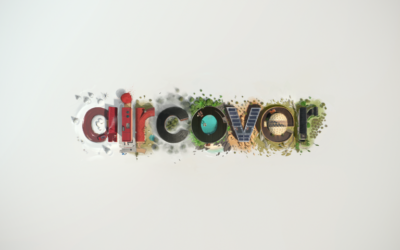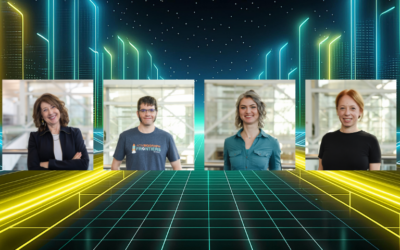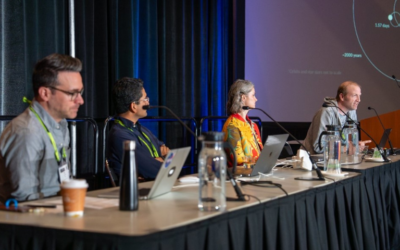Image Credit: “Wheelchair Dance Movement Quality Visualization Overlapped on Dancer Choreography” © Kenta Kambara
SIGGRAPH is thrilled to sit down with the researcher behind the award-winning Art Paper, “Movement Quality Visualization for Wheelchair Dance.” Here, Yurui Xie discusses the inspiration behind this research and shares how the visualization solution celebrates the uniqueness of wheelchair dancers. Read on to learn more about this research and the dancers who inspired it.
SIGGRAPH: Share some background about “Movement Quality Visualization for Wheelchair Dance.” What inspired your team to pursue this research?
Yurui Xie (YX): The inspiration started when one of our researchers encountered a wheelchair dancer in a hip-hop dance workshop full of able-bodied dancers. For those two intense hours, this dancer defied expectations. With a blend of practiced choreography and improvised moves born from her unique ability, she ruled the dance floor. Her confidence wasn’t just in her dance; it was in how she seamlessly fused with her wheelchair, turning it in sync with each pop and lock movement. The room erupted with applause and cheers, the atmosphere alive with an infectious spirit. What struck us most was how, despite the choreography not always aligning with her wheelchair’s motion, she crafted something extraordinary. It wasn’t about perfection, but the authentic quality of her movement that held everyone captive. Her dance wasn’t just a performance, it was a testament to the power of human expression. This encounter shifted our perspective, prompting us to explore disability art in a new light. It made us question the boundaries of artistic movement — could the act of maneuvering a wheelchair be an art form in itself? Could it contribute to a rich tapestry of dance vocabulary? We want to use this research as the start of a journey to celebrate disability art without confines and to offer a platform where dance is a canvas for empowering and inclusive expression.
SIGGRAPH: How does your research advance the goal of creating greater representation for people with disabilities, especially given that wheelchair dance is an important form of disability art?
YX: Our research centers on a visualization solution celebrating the uniqueness of wheelchair dancers. In the technological deployment, we introduced an approach to reconstruct body perception for movement tracking and pose estimation that blurs the lines between dancers and their assistive tools, forming an organic connection. Simultaneously, by incorporating time-honored dance methodologies such as Laban Movement Analysis, we bridge wheelchair dance with established artistry. This synthesis dismantles preconceived stigmas and opens the door to include assistive tools and disability in artistic evaluation independent from abled dancers. The visualization of movement quality explores and looks beyond the surface of movement, shedding light on the profound artistic expression while seeking to eliminate the ableist bias associated with using a wheelchair. Through these three aspects, the identity of wheelchair and dancer is enmeshed, where the assistive tool is no longer a medical or recreational device. Instead, it is included in movement analysis and taken part in artistic expression. The role of the wheelchair is no longer solely an assistive tool, rather part of art creation orchestrated by the dancer. By delving deeper, we try to unveil a hidden layer of enriched artistic value and inviting a fresh appreciation for wheelchair dancers to hone their own craft.
SIGGRAPH: This research developed a visualization system grounded on Laban Movement Analysis (LMA) that notates movement quality while opening new horizons on perceptions of disabled bodies and the artistic legitimacy of wheelchair dance. Explain how this technology will improve the lives and practices of wheelchair dancers.
YX: Wheelchair dance exists within a small and scattered community of artists, often spanning various regions and countries. It is extremely hard to practice and perform for wheelchair dancers due to a number of limitations. Our system champions the artistic value of wheelchair dance, aiming to inspire more participation and contributions. This system offers wheelchair dancers the versatility of real-time interaction and post-processing. It serves as a platform for both movement exploration and the creation of movement notation. By integrating Laban Movement Analysis, we provide wheelchair dancers a place within the established dance community. Our aim is to foster information exchange and secure recognition for wheelchair dance as a legitimate art form. Crucially, our research extends the chance for wheelchair dancers to forge connections, delve into their artistic practice, and cultivate a supportive community. Similar to dance styles with minority origins such as voguing and krumping, establishing these connections has the potential to thrust wheelchair dance into the spotlight of its profound artistic value. The bigger picture we envision is promoting an inclusive society where disability can be appreciated as an artistic expression.
SIGGRAPH: Your Art Paper was presented at SIGGRAPH 2023 in Los Angeles, and you received the Best Art Paper award. Congratulations! What was it like to present it to the audience? What does this award mean to your team?
YX: Presenting our Art Paper at SIGGRAPH 2023 in Los Angeles was an exhilarating experience. The presentation itself went nicely, and the following question session offered a fresh perspective that could potentially impact our ongoing research. Engaging with the audience further ignited innovative ideas and facilitated connections with potential collaborators who share our vision. Receiving the Best Art Paper award holds profound meaning for our team. It stands as a recognition of our tireless efforts, particularly in disability art and wheelchair dance. This recognition fuels our motivation to continue delving into this field, propelling us toward future research and creative endeavors with even greater determination. The award resonates as both a celebration of our past achievements and an inspiration for what lies ahead.
SIGGRAPH: What advice do you have for someone planning to submit their own research to a future SIGGRAPH conference?
YX: SIGGRAPH offers an incredible avenue for interaction with exceptional researchers, institutions, and industry experts. The innovations on display are truly inspiring. As researchers, we serve as both trailblazers in innovation and bridges that connect society and humanity to the advancements in technology. Our advice is more of an envisioning of the future, where diverse subcultures and communities become integral participants in this technological renaissance, collectively contributing to a more enriched tapestry of human creativity.
SIGGRAPH 2023 was thrilled to celebrate its 50th conference this August in Los Angeles. There’s still time to access select content on-demand. Visit the SIGGRAPH 2023 website to learn more.

Yurui Xie is a graduate student at Keio University Graduate School of Media Design, on track to complete her master’s degree in media design in September 2023. Her research explores the kinaesthetic experience and the intangibles of motion. Specifically, she is interested in exploring methods and technologies such as computer graphics, data-enabled design, and an intelligent system to develop adaptive tools that promote inclusivity in artistic or creative practices across various disciplines.

Kenta Kambara is a wheelchair dancer based in Tokyo, Japan. While Kambara suffers from Spina Bifida, he has not let that stop his passion from dance, which led to him from performing in both the Rio 2016 Paralympic Closing Ceremony as well as the Tokyo 2020 Paralympic Opening Ceremony.

Sofie Cox started dancing at the age of nine. She is a multiple Belgian champion and competes all over the world in solo dancing. In 2014, she competed in her first European Championship and won a bronze medal in solo freestyle. In 2018, she became Vice-European Champion in solo ladies and repeated her bronze medal in solo freestyle. And in 2022, she became two-time Vice-European champion. On a world level, she is a top-six dancer. Her motto has always been: “Don’t tell me the sky’s the limit, when there are footprints on the floor.”

Mehmet Arak is from Izmir, Turkey, and has been involved in the wheelchair dance project for 10 years as a dancer. After receiving numerous national and international awards in Wheelchair Dance, their ultimate goal is to showcase to the whole world that dancing can be done in a wheelchair.



